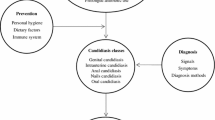Abstract
An eight-years-old girl, who presented with recurrent upper respiratory tract infections, was treated with broad-spectrum antibiotics. Afterward she presented with intestinal candidiasis. The isolated species was identified as Candida albicans by differential tests. Treatment given was with 500,000 IU of oral nystatin every 8 hours for 10 days and intestinal normal microbiota restoratives. Evolution has been satisfactory, although concomitantly type A hepatitis developed. Rest and a soft diet were recommended. The child is now perfectly healthy with normal liver function tests. Conclusion: Prolonged treatments with broad-spectrum antibiotics destroyed the indigenous intestinal microbiota, which provoked intestinal C. Albicans proliferation and adversely affected the immunological system of the patient, thus facilitating the establishment of a viral infection.
Similar content being viewed by others
References
Kennedy MJ, Volz PA. Ecology of Candida albicans gut colonization: Inhibition of Candida adhesion, colonization and dissemination from the gastrointestinal tract by bacterial antagonism. Infect Immunity 1985; 49: 654–663.
de Repentigny L, Aumont F, Bernard K, Belhumeur P. Characterization of binding of Candida albicans to small intestinal mucin and its role in the adherence to mucosal epithelial cells. Infect Immunity 2000; 68: 3172–3179.
Colina AR, Aumont F, Deslauriers N, Bellmineur P, de Repentigny L. Evidence for degradation of gastrointestinal mucin by Candida albicans secretory aspartyl proteinase. Infect Immunity 1996; 64: 4514–4519.
Bond S, Stwart DL, Bendon CW. Invasive Candida enteritis in the new born. J Pediatr Sur 2000; 35: 1496–1498.
Stachowitz S, Abeck D, Schmiath T, Ring J. Persistent annular erythema of infancy associated with intestinal Candida colonization. Clin Exp Derm 2000; 25: 404–405.
Isenberg HD, Pisano MA, Carito SL, Berkman JI. Factors leading to overt monilial disease. Preliminary studies of the ecological relationship between Candida albicans and intestinal bacteria. Antibiot Chemother 1960; 6: 353–363.
Seelig MS. Mechanisms by which antibiotics increase the incidence and severity of candidiasis and alter the immunological defenses. Bacteriol Rev 1966; 30: 442–459.
Seelig MS. The role of antibiotics in the pathogenesis of Candida infections. Am J Med 1966; 40: 87–917.
Wals TJ, González C, Klyman CA, Chanock SJ, Pizzo PA. Invasive fungal infections in children: Recent advances in diagnosis and treatment. Adv Pediatr Infect Dis 1996; 11: 180–290.
Fisher-Hoch S, Huatwagner L. Opportunistic candidiasis: An epidemic of the 80's. Clin Inf Dis 1995; 21: 897–904.
Bandarinarayanan G, Gowrisankar R, Muthulakshmi K. Esophageal candidiasis in non-immune suppressed patients in a semi-urban town, southern India. Mycopathologia 2000; 149: 1–4.
Zimmerman LE. Fatal fungus infections complicating other diseases. Am J Clin Pthol 1995; 25: 46–65.
Alam SA, Tahir M, De MN. Candida as a cause of diarrohoea in children. Bangladesh Med Res Counc Bull 1977; 3: 32–36.
Wagner RD, Warner T, Pierson C, Roberts L, Farner J, Dohnalek M, Hilty M, Balish E. Variable biotherapeutic effects of Biffidobacterium spp. on orogastric and systemic candidiasis in immunodeficient mice. Rev Iberoam Micol 1998; 15: 265–270.
Wagner RD, Warner T, Roberts L, Farmer J, Dohnalek M, Hilty M, Balish E. Variable biotherapeutic effects of Lactobacillus acidophilus isolates on orogastric and systemic candidiasis in immunodeficient mice. Rev Iberoam Micol 1998; 15: 271–276.
Berg R, Bernasconi P, Fowler D, Gantreux M. Inhibition of Candida albicans translocation from the gastrointestinal tract of mice by oral administration of Sacharomyces boulardii. J Inf Dis 1993; 168: 1314–1318.
Hilton E, Isenberg HD, Alperstein P, France K, Borentein M. Ingestion of yogurt containing Lactobacillus acidophilus as prophylaxis for candidal vaginitis. Ann Intern Med 1992; 116: 353–357.
Symposium LACTEOL 2000 Nuevas Perspectivas Fundamentales y Clínicas sobre el uso Terapéutico del liofilizado del termolizado de Lactobacillus acidophilus boucardii cepa L.B. en el tratamiento del Síndrome Diarreico. Rev Enf Pediatr 2001; Vol. XIV, NÚmero especial.
Author information
Authors and Affiliations
Rights and permissions
About this article
Cite this article
Ruiz-Sánchez, D., Calderón-Romero, L., Sánchez-Vega, J.T. et al. Intestinal candidiasis. A clinical report and comments about this opportunistic pathology. Mycopathologia 156, 9–11 (2003). https://doi.org/10.1023/A:1021326713470
Issue Date:
DOI: https://doi.org/10.1023/A:1021326713470




